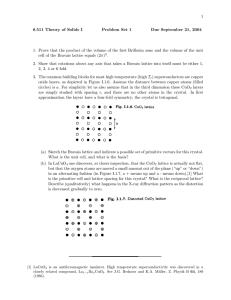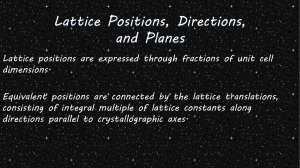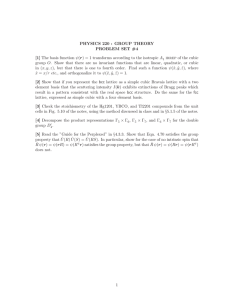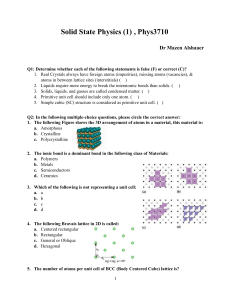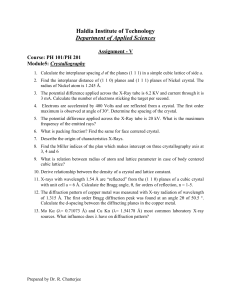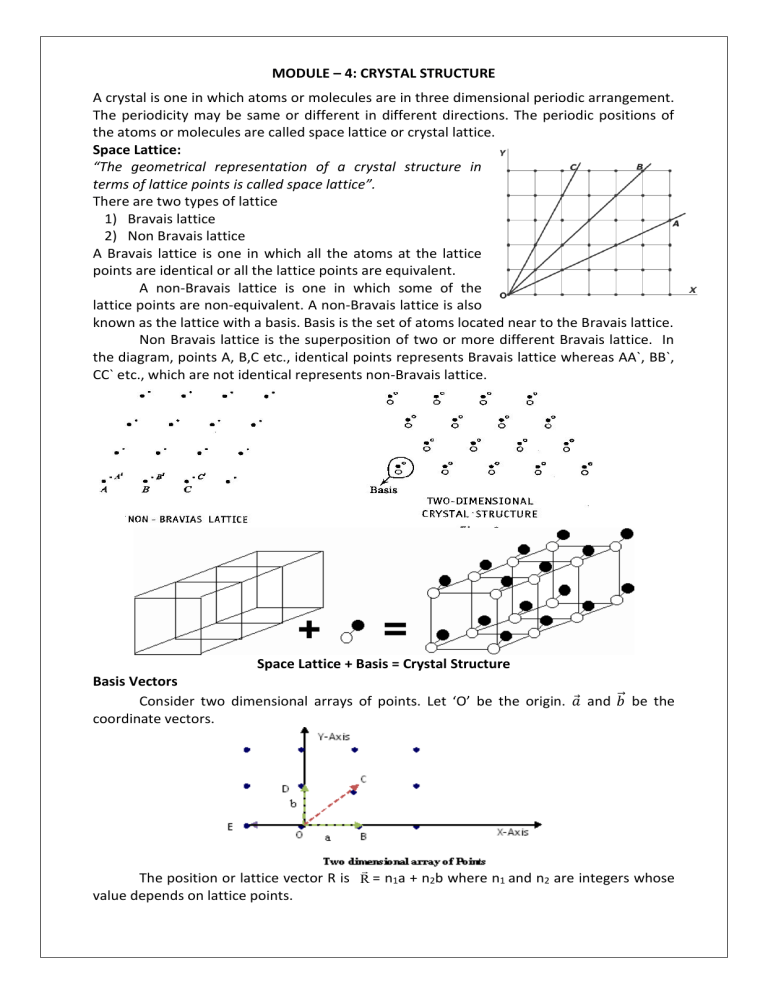
MODULE – 4: CRYSTAL STRUCTURE A crystal is one in which atoms or molecules are in three dimensional periodic arrangement. The periodicity may be same or different in different directions. The periodic positions of the atoms or molecules are called space lattice or crystal lattice. Space Lattice: “The geometrical representation of a crystal structure in terms of lattice points is called space lattice”. There are two types of lattice 1) Bravais lattice 2) Non Bravais lattice A Bravais lattice is one in which all the atoms at the lattice points are identical or all the lattice points are equivalent. A non-Bravais lattice is one in which some of the lattice points are non-equivalent. A non-Bravais lattice is also known as the lattice with a basis. Basis is the set of atoms located near to the Bravais lattice. Non Bravais lattice is the superposition of two or more different Bravais lattice. In the diagram, points A, B,C etc., identical points represents Bravais lattice whereas AA`, BB`, CC` etc., which are not identical represents non-Bravais lattice. Space Lattice + Basis = Crystal Structure Basis Vectors Consider two dimensional arrays of points. Let ‘O’ be the origin. 𝑎⃗ and 𝑏⃗⃗ be the coordinate vectors. The position or lattice vector R is R = n1a + n2b where n1 and n2 are integers whose value depends on lattice points. For B, (n1, n2) = (1,0) For C, (n1, n2) = (1,1) For D, (n1, n2) = (0,1) For E, (n1, n2) = (-1,0) Unit Cell and Lattice Parameters A unit cell is the smallest portion of the space lattice, which on repetition along the direction of three basis vectors generates the space lattice itself. Unit cell has basis vectors𝑎⃗, 𝑏⃗⃗ & 𝑐⃗⃗⃗ and interfacial angles α, β & γ. The basis vectors 𝑎⃗, 𝑏⃗⃗, 𝑐⃗ and interfacial angles α, β & γ are the lattice parameters. Each unit cell has only one lattice point because there are eight points at its corners and each point is shared by eight adjacent cells. Primitive cell and non-primitive cell Consider a Bravais lattice in two dimensions as shown in figure. A unit cell with basis vectors a1 & b1 has four lattice points at the vertex. It is a primitive cell. The other unit cell with basis vectors ⃗⃗⃗⃗⃗ 𝑎2 and ⃗⃗⃗⃗⃗ 𝑏2 has an additional lattice point at the center along with four points at the corners, which is not the meeting point of the basis vectors. This is non-primitive cell. A primitive cell is a unit cell with all the points in it are at the vertices. A non-primitive cell is a unit cell which incorporates an integral multiple of primitive cells and is imagined only for the sake of easy visualization of the symmetry in the arrangement of the lattice points. Crystal systems: There are seven crystal systems named on the basis of geometrical shape and symmetry. The seven crystal systems are further divided into 14 Bravais lattice. The simple lattice has points only at the corners. The Body centered lattice has an additional point at the centre of the cell The Face centered lattice has six additional points one on each face. The base centered lattice has two additional points one at the bottom face and other at the top face. The seven crystal systems and the 14 Bravais lattices are represented in the following table: 1. Cubic abc 90o Simple (SC) Body- Centered (BCC) Face-centered (FCC) Ex: Au, Cu, NaCl, CaF2, 2. Tetragonal abc 90o Simple Body-centered Ex: SnO2, TiO2, NiSO4. 3. Orthorhombic abc 90o Simple Base-centered Body-centered Face-centered Ex: KNO3, BaSO4, MgSO4. 4. Trigonal (or) Rhombohedral Simple abc 90o Ex: calcite, quartz, Bi 5. Hexagonal abc 90o Simple 120o Ex: SiO2, Zn, Mg, 6. Monoclinic abc 90o 90o Ex: CaSO4, FeSO4, Na2SO4 Simple Base-centered 7. Triclinic abc 90o Ex: K2Cr2O7, CuSO4 Simple Miller indices of directions and planes: Miller has introduced three numbers to explain the planes and directions in a crystal. These numbers are called Miller indices. A Miller indices is basically a vector between two points in the crystal. Any direction can be defined by following a simple procedure: 1. Choose the position vector, so that it is in convenient position within your chosen coordinate system. 2. Find the projection of the vector onto each of the three axes in terms of the unit cell dimensions. 3. To get the Miller Index we express the vector as a set of whole number, and enclose in square brackets. Example: A cubic unit cell along with miller indices of directions. Procedure to find miller indices of planes: 1. 2. 3. 4. Find the intercepts of the planes along x, y and z axis Express the intercepts as multiples of lattice constants a, b, c. Find out the reciprocal of these numbers. Find the least common multiple (LCM) of the denominator and multiply each term with LCM. 5. The result is in the form of h, k, l. are called miller indices, denoted by (h k l) Intercepts Reciprocals Whole numbers Miller indices 2a 1b 1c 1/2 1/1 1/1 1 2 2 2a 1b c 1/2 1/1 1/ 1 2 0 (1 2 2) (1 2 0) 1a –1b 2c 1/1 -1/1 1/2 2 2 1 (2 2 1) -1a 2b –1c -1/1 1/2 -1/1 2 1 2 (2 1 2) Few examples for obtaining the Miller indices Calculation of miller indices Following points should be noted 1. The negative digit indicates cutting of axis on the negative side of the origin. 2. Zero index indicates that the plane is parallel to corresponding axis. 3. A parallel set of planes have same miller indices. Example: The planes have intercepts 4, 1, 2 1. x : y : z = 4 : 1 : 2 1 1 1 2. Reciprocals 4 ∶ 1 ∶ 2 3. LCM = 4 1 1 4. 4 × 4 : 4 × 1 : 4 × 2 The miller indices are 1, 4, 2 i.e. 1:4:2 By knowing the Miller indices we can draw the planes within the unit cell. The two Figures showed below gives the idea of drawing the planes with in the unit cell. 1) The Fig. shows the plane with Miller indices (110) 2) The Fig. shows the plane with Miller indices (020) Due to the symmetry of crystal structures the spacing and arrangement of atoms may be the same in several directions. These are known as equivalent directions. A group of equivalent directions is known as a family of directions denoted by < h k l>. Similarly the set of equivalent planes are known as a family of planes is denoted by [h k l]. Miller indices of directions Family of planes is denoted by [h k l] and Family of Directions is denoted by < h k l> Expression for inter-planar spacing in terms of Miller indices: Consider a plane ABC which belongs to a family of planes. h, k, l are the Miller indices of this plane, which represents the set of planes. The perpendicular OP from the origin O to the plane represents the inter-planar spacing d =OP of this family of planes. Let OP make an angle α, β, γ with the x, y, z axes respectively The intercepts of the plane on the three axes are OA = a/h ; OB = b/k ; OC = c/l Where a, b and c are cell edge parameters Then from figure, we have d d d h cos OA a / h a d d d k cos OB b / k b ………...1 cos d d d l OC c / l c For the orthogonal coordinates cos2 cos2 cos2 1 Substituting the values of cos , cos, cos in equation (2), We get, 2 2 ……….. 2 2 dh dk dl a b c 1 For cubic system, a b c d2 2 2 h k 2 l2 1 a d a h k 2 l 2 2 This is the relation between inter-planar spacing‘d’ and the edge of the cube ’a’. It should be noted that this formula is applicable only to primitive lattices in cubic, orthorhombic and tetragonal systems. Spacing between the planes 100, 110 and 111 d hkl a if [h k l] = [100], d100 2 2 2 h k l a a 12 0 0 If [h k l] = [110], d 110 a a 12 12 0 2 If [h k l] = [111], d111 1 2 a 1 1 2 2 a 3 Expression for space lattice constant ‘a’ for a cube lattice Let ‘a’ be the lattice constant, ‘ρ’ be the density of the material and ‘n’ be the number of molecules in a unit cell. Total mass of molecules in a unitcell Volume of the unit cell The total mass of the molecules in one kilo mole of substance is equal to the molecular weight of the molecule expressed in kg. Therefore the mass of each molecule = M/NA Where NA is Avagadro number The total mass of the molecule nM NA For a cubic lattice a = b = c ... The volume of the unit cell = a3 1 nM Hence, the density ( ρ ) is = 3 a NA nM nM 3 a a NA NA 1. Simple cubic structure (SC): 3. Face centered cubic structure (FCC): Properties of the Unit cell (Cubic) 3 2. Body centered cubic structure (BCC): 1. Volume of a unit cell: The general expression for finding the volume a unit cell is V abc1 cos cos cos 2 cos cos cos 2 2 2 1 2 Where a, b, c, , and are called lattice parameters. For cubic system a = b = c and = = = 900. Therefore V = a3. 2. Co-ordination number: It is the number of nearest neighbours directly surrounding a given atom well within a crystal. The co-ordination number for an atom in simple cubic structure is = 6 The co-ordination number for an atom in body centered cubic structure is = 8 The co-ordination number for an atom in face centered cubic structure is =12 3. Number of atoms per unit cell: In a unit cell atoms are at the corners, at the center of the faces and at the center of the body. An atom situated at the corner share 1/8th part to a unit cell. An atom situated at the face share 1/2 part to a unit cell. An atom situated at the center of the body share one full part to a unit cell. 1. In a simple cubic structure there are 8 corner atoms. ... Total share of all the corner atoms/unit cell = (1/8)×8 =1 ... The number of atoms/unit cell in simple cube = 1 2. In a body centered cubic structure there are 8 corner atoms and an atom at the center of the unit cell. ... Total share of all the corner atoms per unit cell = (1/8)×8 = 1 The share of an atom at the center of the body =1 ... The number of atoms per unit cell in body centered cube = 1+1=2 3. In a face centered cubic structure there are 8 corner atoms and 6 face centered atoms in a unit cell. ...total share of atoms at the corner/unit cell = (1/8) ×8=1 Total share of atoms at all the faces/unit cell = (1/2) ×6=3 . . . The number of atoms/unit cell in face centered cube = 1+3 = 4 Atomic packing factor (APF) The fraction of the space occupied by atoms in a unit cell is known as atomic packing factor. It is the ratio of the total volume occupied by the atoms in the unit cell to the total available volume of the unit cell. Total volume accupied by all the atoms in the unit cell pf = Volume of unit cell n 4 pf = 3 πr 3 a 3 1. Simple cubic structure (SC): There is only one lattice point at each of the eight corners of the unit cell. Since each atom in the corner is shared by 8 unit cells, the total number of atoms in one unit cell is (1/8) ×8 = 1 The nearest neighbor distance ‘2r’ is the distance between the centers of two nearest neighboring atoms. The nearest neighbor distance 2r = a The number of atoms per unit cell = 1 4 Volume of each atom in a unit cell V r 3 3 1 4 a n 4 Packing factor, pf = 3 πr 3 = 3 π 0.52 52% a 3 a 3 2 6 3 2. Body centered cubic structure (BCC): In a BCC structure eight atoms are present at eight corners and one atom is at the center. The coordination number is 8. The number of atoms per unit cell is = [ (1/8) × 8 ] + 1 = 2 The lattice constant is CA2 = a2 + a2= 2a2 CF2 = CA2 + AF2 4r2 = 2a2 + a2 = 3a2 Lattice constant a 4r or r 3 a 4 3 3 3 2 4 3 a n 4 0.68 68% Packing factor, pf = 3 πr 3 = 3 π 8 a 3 4 a 3 3. Face centered cubic structure (FCC): In a FCC structure eight atoms are at the corners of the unit cell and six atoms are present at the center of the six faces. The center atom is surrounded by 12 points. The co-ordination number is 12. Each corner atom is shared by 8 unit cells and the face centered atom is shared by 2 surrounding unit cells. ... The number of atoms per unit cell is = 4 Atomic radius of face centered cube AB = 4r AB2 = a2 + a2 4r2 = 2a2 Lattice Constant a = 2 2r 4 n 4 3 4 πr 3 0.74 74% Packing factor, pf = 3 πr = 3 3 2 a 3 2 2 r 3 Parameters SC BCC FCC Co-ordination number Cell edge in terms of Atomic Radius (r) Atoms per unit cell Atomic packing factor 6 a 2r 1 = 0.52 6 8 a 4 r 3 2 3 = 0.68 8 12 a2 2 r 4 2 = 0.74 6 Bragg’s Law: Consider a set of parallel planes called Bragg’s planes. Each atom is acting as a scattering center. The intensity of the reflected beam at certain angles will be maximum when the path difference between two reflected waves from two adjacent planes is an integral multiple of λ. Let ‘d’ be the distance between two adjacent planes, 'λ’ be the wavelength of the incident x-ray, ‘θ’ be the glancing angle. The path difference between the rays reflected at A & B is given by = CB + BD From triangle ACB CB sin CB d sin AC Similarly From triangle ADB BD sin BD d sin AC Path difference, CB DB d sin d sin 2d sin From the condition for the diffraction The path difference = nλ, 2d sin n Where ‘n’ is the order of scattering. This is called Bragg’s law Bragg’s x-ray spectrometer: The schematic diagram of Bragg’s x-ray spectrometer is shown in fig. It is used to determine lattice constant and inter-planar distance‘d’. It has 1) x-ray source 2) A Crystal fixed on a circular table provided with scale and vernier. 3) Ionization chamber. A collimated beam of x-rays after passing the slits S1 and S2 is allowed to fall on a crystal C mounted on a circular table. The table can be rotated about vertical axis. Its position can be measured by vernier V1. An ionization chamber is fixed to the longer arm attached to the table. The position of which is measured by vernier v2. An electrometer is connected to the ionization chamber to measure the ionization current produced by diffracted x-rays from the crystal. S3 and S4 are the lead slits to limit the width of the diffracted beam. Here we can measure the intensity of the diffracted beam. If x-rays incident at an angle ‘θ’ on the crystal, then reflected beam makes an angle 2θ with the incident beam. Hence the ionization chamber can be adjusted to get the reflected beam till the ionization current becomes maximum. A plot of ionization current for different incident angles to study the x-ray diffraction spectrum is shown in fig. The rise in Ionization current for different values of ‘θ’ shows that Bragg’s law is satisfied for various values of ‘n’. i.e. 2dsinθ = λ or 2λ or 3λ etc. Peaks are observed at θ 1, θ2, θ3 etc. with intensities of P1, P2,P3 etc. i.e. 2dsinθ1 : 2dsinθ2 : 2dsinθ3 = λ : 2λ : 3λ The crystal inter-planer spacing‘d’ can be measured using 2dsinθ = nλ If d1, d2, d3 be the inter-planar spacing for the planes (100), (110) & (111) respectively. It can be shown 1 1 For cubic crystal : d1:d2:d3 = 1: : For FCC : d1:d2:d3 = 1: For BCC : d1:d2:d3 = 1: √2 √3 1 2 : √2 √3 2 1 : √2 √3 Crystal structure of Diamond: The diamond lattice can be considered as the superposition of 2 fcc sublattices one of which is displaced from the other along the body diagonal of the unit cell by (1/4) th the length of the diagonal. Thus a carbon atom will be present at the center of tetrahedron, with four carbon atoms of the other sublattice as its nearest neighbours located at four corners of the same tetrahedron. Thus the co-ordination number of diamond is 4 and there will be 8 carbon atoms present per unit cell. That is each carbon atom is at the center of a tetrahedron, 4 carbon atoms are at diagonally opposite in the planes. The lattice constant is 3.5Ao and the bond length is 6.56Ao. The semiconductors like Si and Ge are having diamond structure. An FCC lattice has 4 atoms/unit cell. But the diamond lattice comprises of two interpenetrating FCC sub-lattice. Therefore, Number of atoms per unit cell in the diamond lattice is 2 x 4 = 8. And Atomic Packing Factor = 8 4 3 8 4 3 r r 3 34% 3 3 a 3 16 8 3 r 3 The positions of carbon atoms are (0 0 0), ( 12 1 2 0), (0 12 1 2 ), ( 14 1 1 4 4 )
